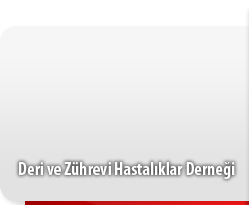Evaluation of the Diagnostic Compliance Between Dermatologist and Patients and Factors Affecting This AgreementYeşim Doğan, Tuğba Rezan Ekmekçi, Zehra Aşiran SerdarDepartment Of Dermatology, Haydarpaşa Training And Research Hospital, İstanbul, Turkey
Background and Design: According to the ICD-coding system, 862 diseases of the cutaneous and subcutaneous tissues. Only few diseases have a Turkish equivalent or a corresponding term in Turkish language. Our aim was to investigate the diagnostic
agreement between dermatologist and patients and the factors affecting this agreement.
Material and Method: The study involved 1479 cooperating patients aged 18 years or above who had applied to Dermatology Outpatient Clinic of Haydarpaşa Numune Training and Research Hospital between September 2009 and April 2010 and had a
disease with a Turkish name or original term. The patients were divided into three groups as their diagnoses were compatible or incompatible to the dermatologists diagnosis or were unfamiliar. The groups were compared statistically for age, gender, education level, effects of disease duration and severity. The groups showing agreement and disagreement were additionally explored for: diagnosing person (patient or physician); when diagnosed by the patient, the information source (friends, parents, media, patients own idea); when diagnosed by a physician, the specialization field (dermatology or other specialties); previous treatment and effect of disease presence in individuals in the patient's environment.
Results: It was found that 829 (56.1%) patients diagnoses were compatible, while 278 (18.8%) were incompatible to the dermatologists diagnosis and 372 (25.5%) were unfamiliar. The agreement between diagnoses was higher in females, youngsters, and in patients with higher education levels, longer disease duration and higher disease severity, presence of friends as information source or a similar disease. The diseases with highest diagnostic agreement were acne vulgaris (95.6%), tinea unguium (82.3%), and tinea pedis (78.9%), whereas the diseases with lowest agreement were nummular dermatitis (10.2%), urticaria (11.9%) and lichen planus (25.9%).
Conclusion: The diagnostic compliance was high between dermatologist and patient in diseases with a Turkish name or original term. Keywords: Dermatologist, patient, diagnosis, compliance
Dermatolog ile Hastalar Arasındaki Tanı Uyumu ve Uyumu Etkileyen FaktörlerYeşim Doğan, Tuğba Rezan Ekmekçi, Zehra Aşiran SerdarHaydarpaşa Numune Eğitim Ve Araştırma Hastanesi, Deri Ve Zührevi Hastalıklar Kliniği, İstanbul
Amaç: ICD kodlama sistemine göre, deri ve derialtı dokusuna ait 862 adet hastalık bildirilmektedir. Bu hastalıkların içinde Türkçe karşılığı olan veya Türkçeleşmiş halleri ile kullanılan az sayıda hastalık vardır. Amacımız, dermatolog ve hastalar arasındaki tanı
uyumu ve bu uyumu etkileyen faktörleri araştırmaktı.
Gereç ve Yöntem: Çalışmaya Eylül 2009-Nisan 2010 tarihleri arasında Haydarpaşa Numune Eğitim ve Araştırma Hastanesi Deri ve Zührevi Hastalıklar polikliniğine başvuran; yaşı 18 ve üzeri, kooperasyon kurulabilen, Türkçede karşılığı olan veya orijinal ismi ile kullanılan bir hastalığa sahip 1479 hasta alındı. Hastanın tanısı ile dermatologun tanısı arasındaki ilişki uyumlu, uyumsuz ve bilmeyen olmak üzere üçe ayrıldı. Üç grupta yaş, cinsiyet, eğitim seviyesi, hastalık süresi ve şiddetinin etkisi istatistiksel olarak karşılaştırılırken; uyumlu ve uyumsuz grupta ayrıca, tanının kimin tarafından konduğu (kendisi, doktor), kendisi koydu ise bilgi kaynağı (arkadaş, aile büyükleri, medya, kendi fikri), doktor koydu ise doktorun uzmanlık alanı (dermatolog ve diğer doktorlar), daha önce tedavi görmesi ve tanıdığı bir kişide bu hastalıktan olmasının etkisi araştırıldı.
Bulgular: Hastaların 829unun (%56,1) uyumlu, 278inin (%18,8) uyumsuz tanı koyduğu, 372sinin (%25,5) bilmediği saptandı. Gençlerde, kadınlarda, eğitim seviyesi yüksek olanlarda, hastalık süresi uzun ve şiddeti fazla olanlarda, tanısı daha önceden
dermatolog tarafından konulanlar ile, bilgi kaynağı arkadaş çevresi olanlarda, ve tanıdığı bir kişide benzer hastalıktan olması durumunda tanı uyumu artmaktaydı. Tanı uyumu en fazla olan hastalıklar, akne vulgaris (%95,6), tinea unguium (%82,3) ve tinea pedis (%78,9) iken, en düşük olan hastalıklar numuler dermatit (%10,2), ürtiker (%11,9) ve liken planus (%25,9) idi.
Sonuç: Çalışmamızda sonuç olarak Türkçede karşılığı olan veya orijinal ismi ile kullanılan bir hastalığa sahip hastalarda dermatolog-hasta tanı uyumu yüksek olarak saptanmıştır. Anahtar Kelimeler: Dermatolog, hasta, tanı, uyum
Yeşim Doğan, Tuğba Rezan Ekmekçi, Zehra Aşiran Serdar. Evaluation of the Diagnostic Compliance Between Dermatologist and Patients and Factors Affecting This Agreement. Turkderm-Turk Arch Dermatol Venereol. 2011; 45(1): 14-18
Corresponding Author: Yeşim Doğan, Türkiye |
|



